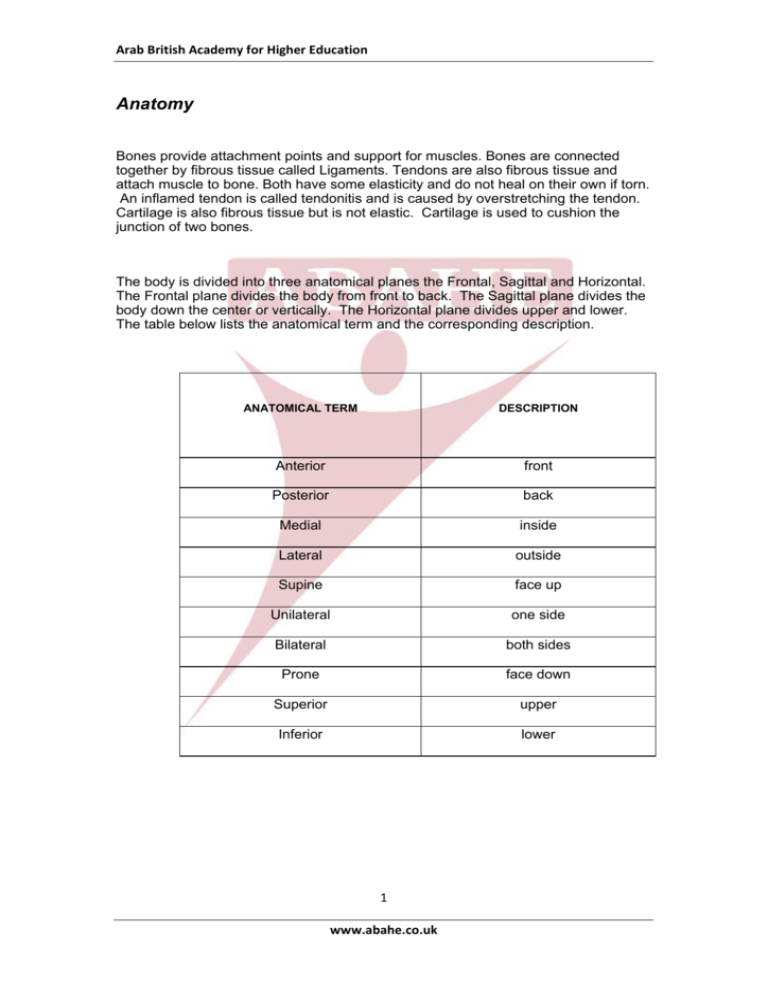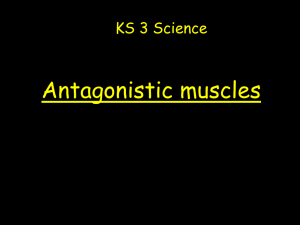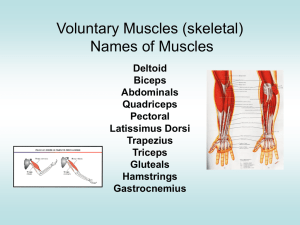
Arab British Academy for Higher Education Anatomy
Bones provide attachment points and support for muscles. Bones are connected
together by fibrous tissue called Ligaments. Tendons are also fibrous tissue and
attach muscle to bone. Both have some elasticity and do not heal on their own if torn.
An inflamed tendon is called tendonitis and is caused by overstretching the tendon.
Cartilage is also fibrous tissue but is not elastic. Cartilage is used to cushion the
junction of two bones.
The body is divided into three anatomical planes the Frontal, Sagittal and Horizontal.
The Frontal plane divides the body from front to back. The Sagittal plane divides the
body down the center or vertically. The Horizontal plane divides upper and lower.
The table below lists the anatomical term and the corresponding description.
ANATOMICAL TERM
DESCRIPTION
Anterior
front
Posterior
back
Medial
inside
Lateral
outside
Supine
face up
Unilateral
one side
Bilateral
both sides
Prone
face down
Superior
upper
Inferior
lower
1 www.abahe.co.uk Arab British Academy for Higher Education Muscle Action
The three types of muscle contraction are Isometric, Isotonic, and Isokinetic.
Isometric is defined as that type of contraction where muscle tension and muscle
length remain constant. This type of exercise provides muscle strength gains but
only at the joint angle held during the exercise. Isotonic contraction is defined as that
where the muscle tension remains constant and muscle length varies. Isokinetic
contraction is defined as varying tension and length.
In each exercise there are four main functions of the associated muscles, Agonists
(prime movers), Antagonists, Stabilizers and Assistors. The Agonists is generally the
muscle we are exercising. The Antagonist is the opposing muscle and acts in
contrast to the agonist. The Stabilizer muscles are those that hold a joint in place so
that the exercise may be performed. The Assistors help the Agonist muscle doing the
work. The stabilizer muscles are not necessarily moving during exercise, but provide
stationary support.
For example, when doing biceps curls, the biceps are the agonists, the triceps are
the antagonists and various muscles including the deltoids are the stabilizer muscles.
However, when doing a triceps push down, now the triceps are the agonists and the
biceps are the antagonists. Again the deltoid muscles are the stabilizer muscles. The
agonist/antagonist relationship changes depending on which muscle is expected to
do the work. However, every muscle group has an opposing muscle group. The
following table lists muscles and their opposing counterparts:
AGONIST (Prime Mover)
ANTAGONIST
Biceps
Triceps
Deltoids
Latissimus Dorsi
Pectoralis Major
Trapezius/Rhomboids
Rectus Abdominis
Erector Spinae
Iliopsoas
Gluteus Maximus
Quadriceps
Hamstrings
Hip Adductor
Gluteus Medius
Tibialis Anterior
Gastrocnemius
2 www.abahe.co.uk Arab British Academy for Higher Education In reference to Agonist and Antagonist, this above list could easily be reversed when
exercising the muscles in the right hand column. Muscle balance is that relationship
between the Agonist and Antagonist. It is important to have muscle balance to
prevent injury. If the Agonist is much stronger than the Antagonist is, the Agonist can
overpower and injure the Antagonist.
Tendons are made up of fibrous tissue and connect muscle to bone. Tendonitis is an
inflammation of the tendon due to overuse. A stretching or tearing of the tendon is
referred to as a strain. A strain is a muscle or tendon injury.
Ligaments are also fibrous tissue and connect bone to bone. They are less flexible
than tendons. The function of ligaments is to restrict the joint movement within
normal parameters. When a ligament is over stretched or torn it is called a sprain.
Since ligaments don't have a vascular system, they may take a very long time to
repair or may never return to their original length. This can cause abnormal joint
movement and even cartilage and bone wear due to this unrestricted movement.
3 www.abahe.co.uk Arab British Academy for Higher Education Joint Action
Joints provide a fulcrum point for muscles to do work. There are six types of joint
action:
JOINT ACTION
MOVEMENT DESCRIPTION
EXAMPLE MOVEMENT
Flexion
decreasing joint angle
Biceps Curl
Extension
increasing joint angle
Triceps Extension
Abduction
movement away from body
centerline
Lateral Raises (Deltoids)
Adduction
movement toward body centerline
Horizontal Flyes (Pectorals)
Rotation
rotation about and axis
Twisting the Arm
Circumduction
360 degree rotation
Arm circle around
All Rights Reserved © Arab British Academy for Higher Education 4 www.abahe.co.uk









